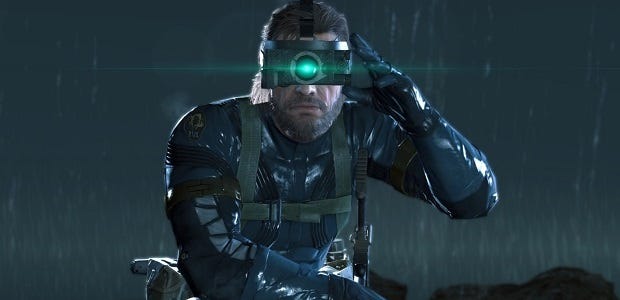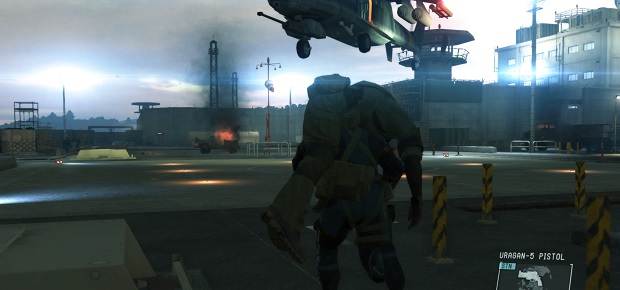Wot I Think: Metal Gear Solid V - Ground Zeroes
This is a sneaking sandbox
Hideo Kojima is one of console-land's greatest champions. Over the past two decades Konami's Kojima-led team, eventually formed into Kojima Productions, has produced classic game after classic game – almost all of which are Metal Gear titles. Though not without critics, each MGS feels like a reinvention rather than a sequel, consistently innovative, stylish, and changeable. And with Metal Gear Solid V: Ground Zeroes, the prologue act to next year's full release of MGSV: the Phantom Pain, Kojima Productions reinvents itself as a PC developer.
What's that - "prologue act"? Isn't this the overpriced demo everyone was moaning about on console six months ago? Ground Zeroes' reception suffered enormously from various reports that it was over in less than an hour, and was a sign of Konami trying to pull a fast one.
What lends these claims credence is that Ground Zeroes takes place in a single environment, and the central story mission can indeed be completed quickly if you know what you're doing. I'd say I could do it in twenty minutes. Ground Zeroes does not end after one mission, so let's put that aside, but it does only have one map on which all the missions are played and no real 'campaign' to speak of.
Camp Omega is a parallel dimension's Guantanamo Bay, an isolated chunk of rock playing host to guards and orange-jumpsuited prisoners. There's a complex next to a helipad, various configurations of buildings, some tented areas, watchtowers, storage facilities, and a fenced area where inmates are kept in cages. An American flag flies proudly over all.
The recent US Senate report confirming the CIA's widespread use of torture at Guantanamo and elsewhere make Camp Omega feel even more timely than it did at launch. In a larger context Ground Zeroes marks a distinct maturation in tone for Kojima – his games have always had big geopolitical themes, but painted with a broad brush and populated with slightly daft characters.
Ground Zeroes still has a bad dude named Skullface, but Camp Omega's focus is so much more specific – with collectable cassette tapes filling in countless details – that it's a direct, emotive broadside. The site of the 9/11 attacks is now known as Ground Zero, and the game's musical theme is a Joan Baez / Ennio Morricone song about two innocent men executed by the USA for anarchist beliefs. The methods and technology of Camp Omega are brutal, while the all-too-human guards and broken prisoners bring home what a truly barbaric achievement it is.
Most important of all, Camp Omega is a great game location, and a new take on what 'open-world' means. This is all about unprecedented detail and variety – a place you learn and master, while constantly finding more. The range of assets used is incredible, meaning every tiny area has an identity, and the layout looks more like a 'real' place than an arena. You know that feeling when you enter a room in a game and instantly see where you'll be taking cover? Ground Zeroes is the opposite.
Essentially what open-world Metal Gear Solid boils down to is freedom of approach. Working your way from the camp's fringes to the inner compound involves a hundred small decisions rather than a straight choice of route, with the terrain's richness creating diversions everywhere. The reason this works is that GZ significantly reworks the Metal Gear control scheme, enormously refining and streamlining a moveset that felt a little baroque by the time of MGS4.
Much of how great it feels comes down to how Big Boss is animated and framed in this uneven environment – when sprinting, the camera zooms in closer as his feet pound through the mud, adjusting their angles exactly to the terrain's contours. Simple changes make an enormous difference. Context-sensitive actions like Big Boss placing his hand on a nearby wall give useful information (I'm in cover) without breaking into the game's flow. The transition between stealth and being spotted is marked by a jolting 'exclamation' sound effect, and a seconds-long minigame where you aim in slow-motion and try to take out the guard before he radios you in and begins an Alert phase.
Big Boss just feels great to control. And there’s an equal thrill to be found in the strange, irresistible mix of intelligence and gullibility in the AI soldiers you're going against. The troops scattered around Camp Omega notice errors, get suspicious about strange footsteps, and have a distressing knack of checking over their shoulder just as you creep up. On Hard mode they become superb antagonists, much smarter and more attentive to suspicious movements. They're great fun to toy with, if you can keep Snake hidden, and the option of interrogating them for tactical information or (even better) holding them up for dog tags soon becomes a compulsion.
The default keyboard and mouse controls are so good I stuck with them, though any action can be re-bound. While aiming with a mouse more than makes up for it, the only real loss is the analogue movement of Snake. This is compensated for by walk / sprint keys modifying the default pace – which works fine, but isn't quite the same.
I couldn't help but feel a little sparkle of Koj dust, too, on noticing that turning on the lights in a vehicle is bound to 'L.' Almost every other key is clustered around your left hand, so you have to quickly glance down and take one hand 'off the wheel' to switch them on.
This might be coincidence in another game. But with Metal Gear Solid you always have total faith in the director's attention to detail. The effects are on another level. When Snake executes a perfect headshot, the sound effect suggests bone being crushed – not in a rewarding way, like a 'ping' in Counter-Strike, but as a vaguely unsettling full stop. When Snake gets shot there's a blood spatter effect – except look closer and you realise it's film stock, burning in the lens.
The point to all of this is that Ground Zeroes, taken at face value, is a small thing. One map, multiple missions. But the more attention you pay, the more there is. I once described this as quality over quantity which, on reflection, isn't quite fair – because the sheer quality of the game gives it much more body than first appears.
A game, for me, justifies its existence if it gives you at least one thing to love. What I love about Ground Zeroes is seeing a gap between two patrolling soldiers I've never seen before – and sprinting across at just the right moment. I love destroying watchtowers with grenade launchers and watching them collapse like Jenga. I love nicking a truck, unseen, and then going around the base at a low enough speed that no-one notices the driver. I love booby-trapping AA guns, calling in my chopper, and sending them sky-high just as it comes in to land. I love choosing the tune that my chopper plays as it descends.
Such things may seem minor. But the greatness of Metal Gear Solid games, and the reason for the fandom surrounding them, is in this blend of stylistic and mechanical integrity. A lot of the value in Ground Zeroes, to put it another way, is in experimenting with consistent tools in one of the best AI toyboxes ever made.
That's not for everyone, and fair enough. Ground Zeroes best serves existing Metal Gear Solid fans, and the kind of player who's into self-improvement. If you like to play a game once and it's done, pass on by. If you're on the fence, wait a few months for it to go on sale. But if you like games about getting better, where you're mastering deep systems and having your skills progressively tested, then Ground Zeroes is the best 50-hour demo you'll ever play.
Metal Gear Solid V: Ground Zeroes is out later today.















